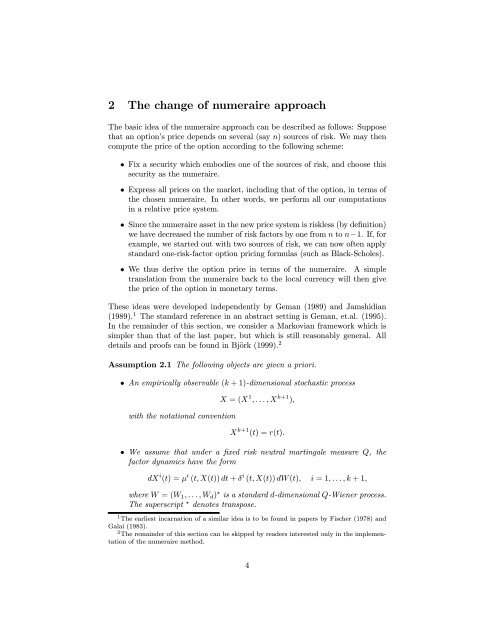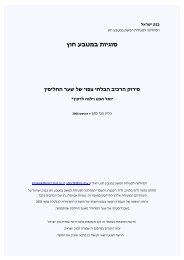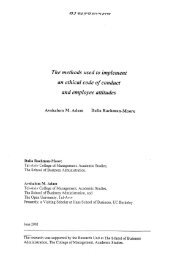ON THE USE OF NUMERAIRES IN OPTION PRICING by Simon ...
ON THE USE OF NUMERAIRES IN OPTION PRICING by Simon ...
ON THE USE OF NUMERAIRES IN OPTION PRICING by Simon ...
You also want an ePaper? Increase the reach of your titles
YUMPU automatically turns print PDFs into web optimized ePapers that Google loves.
2 The change of numeraire approachThe basic idea of the numeraire approach can be described as follows: Supposethat an option’s price depends on several (say n) sources of risk. We may thencompute the price of the option according to the following scheme:² Fix a security which embodies one of the sources of risk, and choose thissecurity as the numeraire.² Express all prices on the market, including that of the option, in terms ofthechosennumeraire. Inotherwords, we perform all our computationsin a relative price system.² Sincethenumeraireassetinthenewpricesystemisriskless(<strong>by</strong>definition)we have decreased the number of risk factors <strong>by</strong> one from n to n¡1. If, forexample, we started out with two sources of risk, we can now often applystandard one-risk-factor option pricing formulas (such as Black-Scholes).² We thus derive the option price in terms of the numeraire. A simpletranslation from the numeraire back to the local currency will then givethe price of the option in monetary terms.These ideas were developed independently <strong>by</strong> Geman (1989) and Jamshidian(1989). 1 The standard reference in an abstract setting is Geman, et.al. (1995).In the remainder of this section, we consider a Markovian framework which issimpler than that of the last paper, but which is still reasonably general. Alldetails and proofs can be found in Björk (1999). 2Assumption 2.1 The following objects are given a priori.² An empirically observable (k +1)-dimensional stochastic processwith the notational conventionX =(X 1 ,...,X k+1 ),X k+1 (t) =r(t).² We assume that under a fixed risk neutral martingale measure Q, thefactor dynamics have the formdX i (t) =µ i (t, X(t)) dt + δ i (t, X(t)) dW (t),i =1,...,k+1,where W =(W 1 ,...,W d ) ? is a standard d-dimensional Q-Wiener process.The superscript ? denotes transpose.1 The earliest incarnation of a similar idea is to be found in papers <strong>by</strong> Fischer (1978) andGalai (1983).2 The remainder of this section can be skipped <strong>by</strong> readers interested only in the implementationof the numeraire method.4






